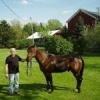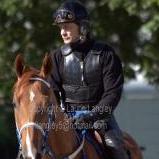-
Content Count
1,033 -
Joined
-
Last visited
About BondoBobCustomSaddles
-
Rank
Leatherworker.net Regular
- Birthday 11/07/1944
Contact Methods
-
Website URL
http://
-
ICQ
0
Profile Information
-
Gender
Male
-
Location
Manchester, Mi.
-
Interests
Saddles,Horses, all leatherwork
LW Info
-
Leatherwork Specialty
Custom Made Saddles and Tack Repair
-
Interested in learning about
Anything Leather
-
threepets started following BondoBobCustomSaddles
-
BondoBobCustomSaddles started following Guitar and Dobro Strap with Carved Name in Floral Design, Latest saddle, Saddle #4 done and and 6 others
-
Bryce, I just thought that I would drop in and see what is going on these days on this sight. Been away for a while, busy with other things. A word about your saddle. Most comments on your saddle are pretty much what I would say. The thing that stands out to me, (my opinion only) is that I would have brought the front and rear jockeys down about another couple of inches. Also, lowered the rear conchos and strings a couple of inches. With that said, then when you "pull/fit" you jockeys like RK said, (making sure they are well wetted) they will pull down tight to the tree and skirts. The horses around here that I have made saddles for usually are more in the 7/8 rigging position. Yours seems to be closer to centerfire, but; then again that is more the need of fitting it to the particular horse that you are making the saddle for. All in all you are getting it done. Nice work, remember the quality is not only in the materials, it in the details. Enoy, Bondo Bob
-
So guess the first part of the previous note didn't make it, what I was trying to say was, pick out the hardest thing to accomplish since you have already built several saddles and know where your downfalls are, and attack it with the mindset that you can do it. I have seen your work over the years and you are ready to achieve that next level. As for cantle bindings, do a std binding with visable stitching. One trick is use not only a stitch wheel on the front, but; on the back also. Next is start an awl from the back to make an exit hole for your front awl. You will be amazed at how the front awl finds the back hole. Make a special effort to keep the amount of tension you put on each stitch the same. The result will give you a reason to be proud. It takes time and effort, but; you'll be glad you took the time to master it. Bob
-
Ok not sure what happened to the note I had started, maybe I got it posted by accident. If so the end of the note is take your time. Once the result is what you want, you will be proud to show it off and know you won. If the front of this note didn't get posted, I will rewrite it later. Bottom line is , take your time, the result is worth the effort. Bob
-
Hi Randy, just thought that I would drop in for a comment or two. You already have most of the you need to take it to the next step. The one thing I do is every time I pick up a piece of leather that has the edge already defined, that is cut and fitted, I give it a good go on the burnisher. Regardless of what else I am going to do with it, stamp, rivet, screw ect. By the time I am ready to assemble for the last time, the edges are where I want them to be, slick and shiny. Also, it is a personal preference, but; I always add some color to the edge, like dk brown or black to the edge of a piece to give it definition. To me it's just a more professional look. Bob
-
I am a 73 year old man looking to make my first saddle. I live in Westland, MI. and would like to stop by and pick your brain if you would allow me. My name is Thomas Valead, and can be contacted by tkvalead@gmail.com or 313-618-0593. I promess not to be a pest. Thank you.
-
Hannah, I just dropped in to see what is going on here, been off all summer, and saw this thread. Most of the advice you have gotten from the guys is spot on. It would have been great to have this forum back when I started but; that was back before dirt was invented Anyway, if you follow the guys advice you won't go wrong. Enjoy the ride! Bob
-

Saddle Identification
BondoBobCustomSaddles replied to blsmothermon's topic in Saddle Identification, Restoration & Repair
Ok, first the style of this saddle is anywhere from 1880 to 1890's give or take 20 years either way. Now then, there are some if's here. If it is original and in that shape, it is amazing. It could however be a repop made any time from then till now. There are some saddlemakers out there that like to make that old timey stuff and do a good job of making it look old with corrosion on the rivets and so on. So with that said, you said that it looks to be 1940-1960's. If it were made in that time frame then it is just that, a 19something saddle made to look like the old style. Bob -
Nice job Billy. Clean and nicely shaped. I am sure she will kike it. Bob
-

Professional Photography - Leather
BondoBobCustomSaddles replied to Newfman's topic in Leather Photography
Hey Newf, good to see you back! I like your work, wish you were close so we could get some good pics of my stuff. All too often, I hear the comment "the pics don't do justice to the real thing" when I deliver a saddle. Look forward to seeing more of our work, and, welcome back! Bob- 2 replies
-
- photso
- photography
-
(and 2 more)
Tagged with:
-

Which first: dye or Tragacanth?
BondoBobCustomSaddles replied to nevadabob's topic in How Do I Do That?
I agree with Sioux . As for me, I quit using Tag a long time ago because I wouldn't use enough to use it all up and alas, it would sit on the shelf and get dried out. I still use saddle soap and water initially, and then die, and lots of elbow grease in between. Usually when I am working on a saddle, I will find myself picking up each piece of the saddle many times during fitting, construction , phiniftering, and final assembly. Each time I pick up a piece I give it a lick on the burnisher. By the time it all goes together, I have achieved the result I like, shiny edges. Bob -

Guitar and Dobro Strap with Carved Name in Floral Design
BondoBobCustomSaddles replied to Chief31794's topic in Guitar Straps
Nice work Chief. Clean and pleasing. Bob -

recommended stamps Engraver turned Leather worker
BondoBobCustomSaddles replied to EngraverGuy's topic in Leatherwork Conversation
Engraver Guy, first, welcome to the forum, second, your engraving is ..., well, it transcends words. Your choice of saddlemakers, and toolers to emulate, bespeaks of a great deal of experience in engraving, and a good eye. It should transfer into leather very nicely. Given your level of artistry in metal, I would suggest you try to achieve that same look in leather. By the way, one of our most notable saddlemakers, was also an engraver, Al Stohlman. Truly something to behold. Please post your work as you progress, and don't wait till it is done, pic along the way are of great interest. Enjoy the ride! Bob -
Just a small tip, what ever you do to clean it up, first with out regard to the back, I would lay out the patterns I want to cut and go ahead and cut them. After having done that, you know exactly what you need to clean off of the back. That way you aren't cleaning the whole side , just the pieces that need it. Sometimes, I use a propane torch on the back of some pieces and singe off the offending "friz", and then depending where it is being used, I may also use a razor skiver to "clean" it off. That hide must have come from a "lazy" cow. Bob
-
Welcome to the forum, you will find lots of help, and sometimes it will be help to you! Maybe some humor to start your day. Enjoy the ride! Bob
-
The problem I have with Weaver is the shipping. Not just the big stuff, but; the little stuff. Did you ever get all you need to do a project only to find at the last minute you are short a snap or some other small item? Happened to me yesterday. Went to the bin to get the small snaps I needed to finish a pair of chaps for a customer that needs them in a few days, and low and behold, I find out I am short to finish them. Don't have the time to wait till I have the next big order so I have to order 6 snaps @ $1 something each, and pay $13.36 shipping , for an $8 order! That's criminal! They could have fitted in an envelope and been shipped for a buck! That's where I get frosted! There is no need for that. Bob



.thumb.jpg.891e1a568fe12892afcab0e6d40cb306.jpg)
